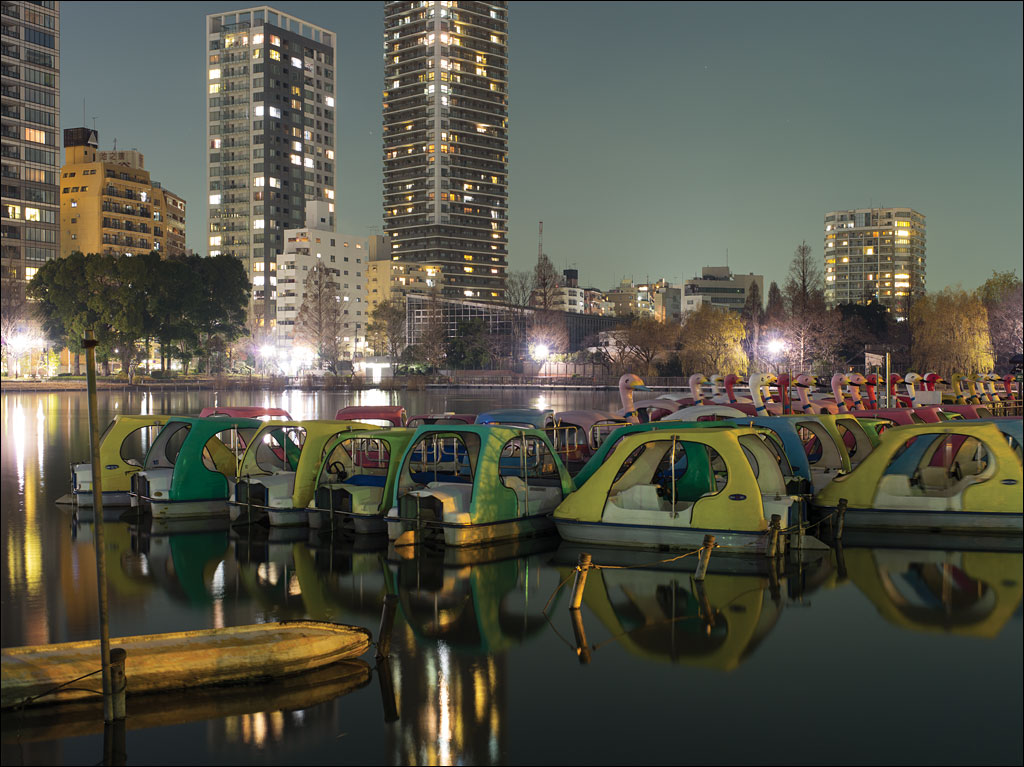 Shinobazu no Ike, or Shinobazu Pond, is located in Ueno Park, Tokyo. This is all that remains of the marsh that has been filled since Edo was established in the seventeenth century. The eastern part of Tokyo was reclaimed from this marsh and is protected by a series of flood walls. During World War II, the pond was used for growing rice. After the war, discussions on whether to convert the area to baseball fields were held. Boating on this pond goes back to 1931. This image is from our book Earth, Water, Fire, Wind, Emptiness: Tokyo Landscapes. Click on the image for a larger view.
Shinobazu no Ike, or Shinobazu Pond, is located in Ueno Park, Tokyo. This is all that remains of the marsh that has been filled since Edo was established in the seventeenth century. The eastern part of Tokyo was reclaimed from this marsh and is protected by a series of flood walls. During World War II, the pond was used for growing rice. After the war, discussions on whether to convert the area to baseball fields were held. Boating on this pond goes back to 1931. This image is from our book Earth, Water, Fire, Wind, Emptiness: Tokyo Landscapes. Click on the image for a larger view.
Category Archives: Japan
Number 3 Daiba
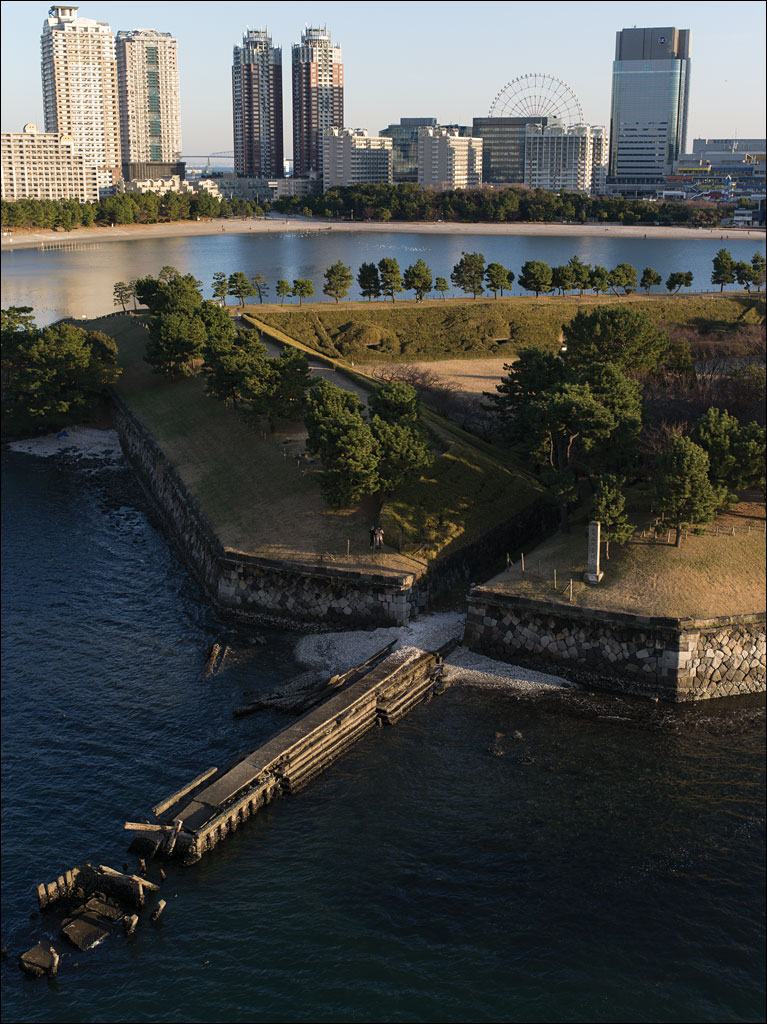 What looks like a peaceful Japanese garden is Number 3 Daiba, a fortification built in 1853 as a response to attempts by US Commodore Perry to open Japan. Beyond that is the artificial island of Odaiba, which was constructed after World War II and one of the planned sites for the 2020 Tokyo Olympic Games. Between the two high-rise apartment building on the left is Tokyo Gate Bridge, the furthest extent of the city into the bay. Number 3 Daiba was originally built several kilometers off the coast of the city in open water. This image comes from our book Earth, Water, Fire, Wind, Emptiness: Tokyo Landscapes. Click on the image for a larger view.
What looks like a peaceful Japanese garden is Number 3 Daiba, a fortification built in 1853 as a response to attempts by US Commodore Perry to open Japan. Beyond that is the artificial island of Odaiba, which was constructed after World War II and one of the planned sites for the 2020 Tokyo Olympic Games. Between the two high-rise apartment building on the left is Tokyo Gate Bridge, the furthest extent of the city into the bay. Number 3 Daiba was originally built several kilometers off the coast of the city in open water. This image comes from our book Earth, Water, Fire, Wind, Emptiness: Tokyo Landscapes. Click on the image for a larger view.
Kasai Rinkai Park
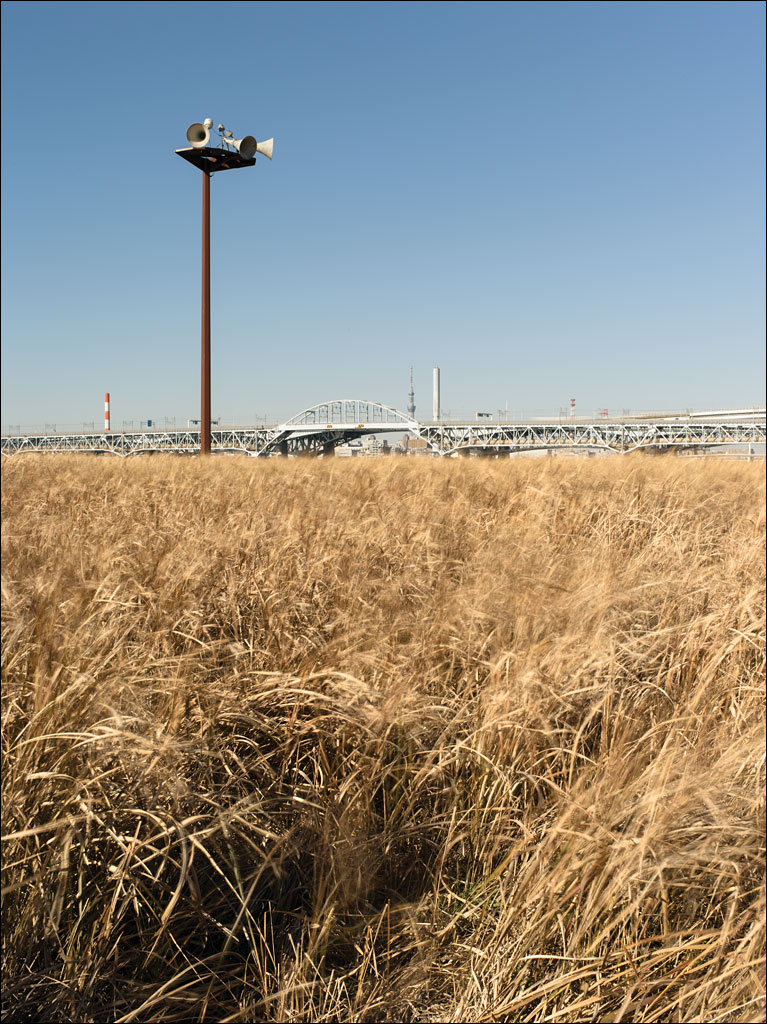 Kasai Rinkai Park is on Tokyo Bay. It is an artificial island built to preserve the natural habitat of Tokyo bay destroyed by development. The bridge in in the background is the main highway that connects Tokyo with Chiba, Tokyo Disneyland, and Narita International Airport. The loudspeakers on the post warn people of approaching tsunamis. This image is from our book Earth, Water, Fire, Wind, Emptiness: Tokyo Landscape. Click on the image for a larger view.
Kasai Rinkai Park is on Tokyo Bay. It is an artificial island built to preserve the natural habitat of Tokyo bay destroyed by development. The bridge in in the background is the main highway that connects Tokyo with Chiba, Tokyo Disneyland, and Narita International Airport. The loudspeakers on the post warn people of approaching tsunamis. This image is from our book Earth, Water, Fire, Wind, Emptiness: Tokyo Landscape. Click on the image for a larger view.
Tokyo Gate Bridge
 If there was a defined edge to the city of Tokyo, this would be it. Tokyo Gate Bridge is the furthest public highway built out into Tokyo bay. The island on the horizon is Chuo Bohatei, Tokyo’s largest landfill, which is reaching the edge of the municipality’s border. This image is from Earth, Water, Fire, Wind, Emptiness: Tokyo Landscape. The image is also an optical illusion: can you tell if the bridge piers are getting thinner or taller the further away they are? Click on the image for a larger view.
If there was a defined edge to the city of Tokyo, this would be it. Tokyo Gate Bridge is the furthest public highway built out into Tokyo bay. The island on the horizon is Chuo Bohatei, Tokyo’s largest landfill, which is reaching the edge of the municipality’s border. This image is from Earth, Water, Fire, Wind, Emptiness: Tokyo Landscape. The image is also an optical illusion: can you tell if the bridge piers are getting thinner or taller the further away they are? Click on the image for a larger view.
Edogawa
 The levee along Edogawa or Edo river is 10m or 30 ft. above the river course. The land on the other side is near sea level. The population density for this Tokyo ward is 13,900 people/km² or 35,900 people/sq. mi. Millions of people are protected from riverine flooding by these structures. This image is from Earth, Water, Fire, Wind, Emptiness: Tokyo Landscape. Click on the image for a larger view.
The levee along Edogawa or Edo river is 10m or 30 ft. above the river course. The land on the other side is near sea level. The population density for this Tokyo ward is 13,900 people/km² or 35,900 people/sq. mi. Millions of people are protected from riverine flooding by these structures. This image is from Earth, Water, Fire, Wind, Emptiness: Tokyo Landscape. Click on the image for a larger view.
Jyonanjima
 Jyonanjima Seaside Park is built on an artificial island in Tokyo bay. Since this island lies on not only the busiest shipping route into Tokyo harbor, but also along one of the flight paths to Haneda International Airport, its popularity is surprising. And while it is one of the few places residents of the city can enjoy a sand beach, the water is too hazardous to allow swimming. Click on the image for a larger view. This is from our book Earth, Water, Fire, Wind, Emptiness: Tokyo Landscape.
Jyonanjima Seaside Park is built on an artificial island in Tokyo bay. Since this island lies on not only the busiest shipping route into Tokyo harbor, but also along one of the flight paths to Haneda International Airport, its popularity is surprising. And while it is one of the few places residents of the city can enjoy a sand beach, the water is too hazardous to allow swimming. Click on the image for a larger view. This is from our book Earth, Water, Fire, Wind, Emptiness: Tokyo Landscape.
Shitamachi
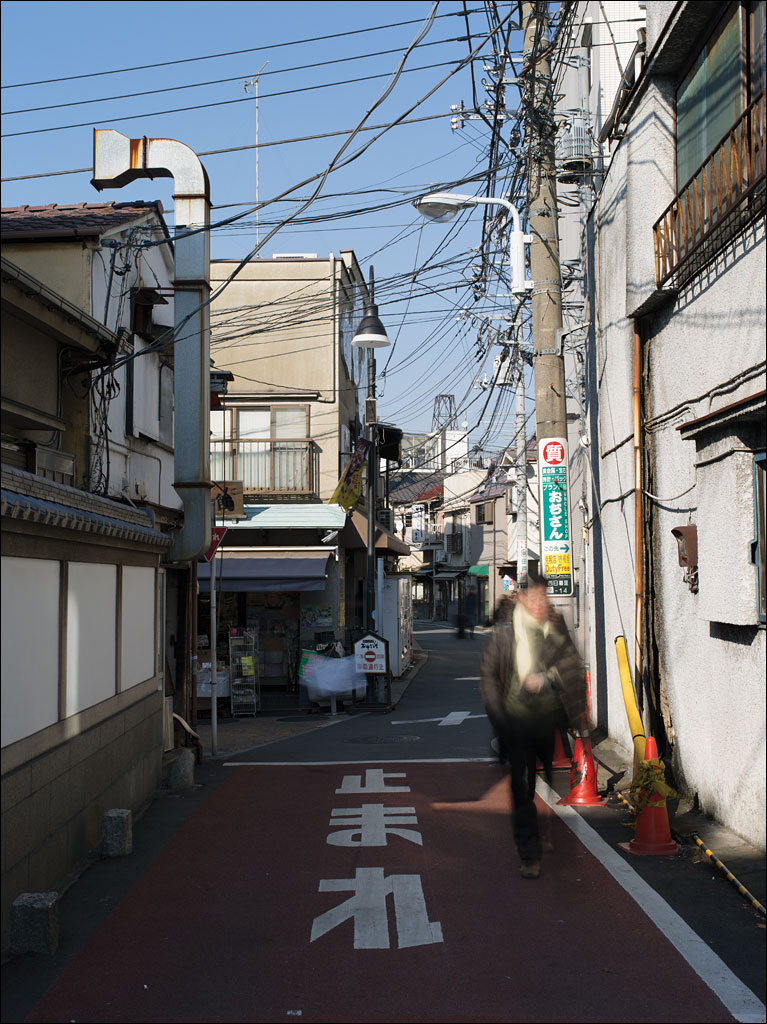 Shitamachi is literally “downtown.” Its connotation is that of an unchanging working-class neighborhood populated by Edokko, or Tokyoites. Tokyo has a reputation as Japan’s modern city, yet sections seem to miss the constant development. Yanaka, just north of Ueno park, is probably one of the most recognized Shitamachi.
Shitamachi is literally “downtown.” Its connotation is that of an unchanging working-class neighborhood populated by Edokko, or Tokyoites. Tokyo has a reputation as Japan’s modern city, yet sections seem to miss the constant development. Yanaka, just north of Ueno park, is probably one of the most recognized Shitamachi.
While Yanaka is well within the modern Tokyo today, that was not always the case. The Great Fire of Meireki in 1657 destroyed 65% of Tokyo, then called Edo, and claimed over 100,000 lives. Thought to have started in a temple, the Tokugawa Shogunate moved many temples outside the city to the north. Yanaka was one of the towns created from that migration. This image is from Earth, Water, Fire, Wind, Emptiness. Click on the image for a larger view.
News: Tsukiji & Athens Photo Festival
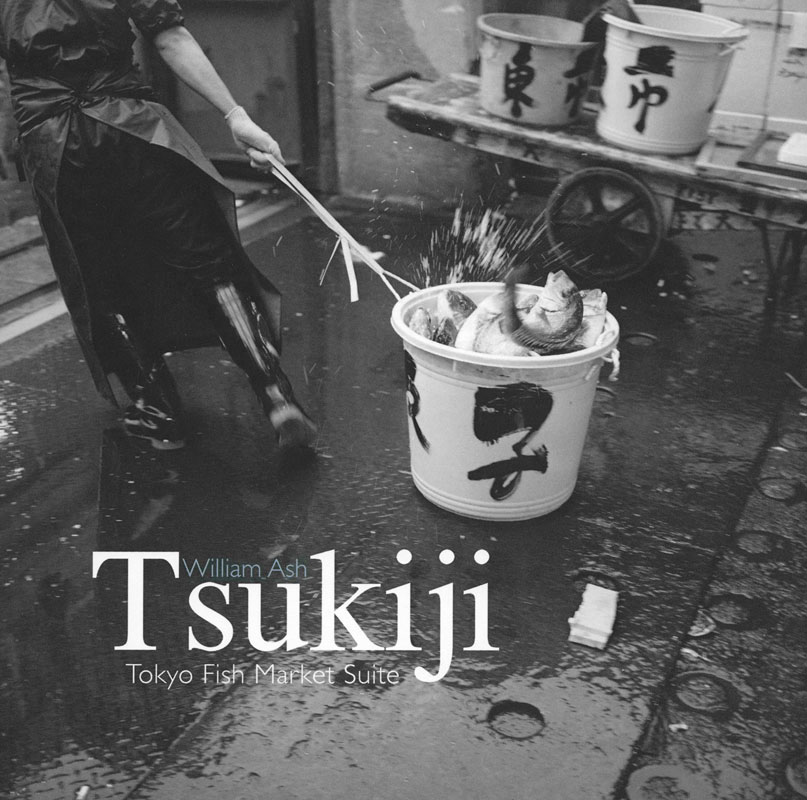 Our latest book Tsukiji: Tokyo Fish Market Suite is now available in our store. You can also read about this book here.
Our latest book Tsukiji: Tokyo Fish Market Suite is now available in our store. You can also read about this book here.
Both Tsukiji: Tokyo Fish Market Suite and Earth, Water, Fire, Wind, Emptiness: Tokyo Landscape were selected for the Photobook Exhibition at Athen Photo Festival 2017. The festival runs from June 14 to July 30 at the Benaki Museum in Athens, Greece.
Photobook Showcase
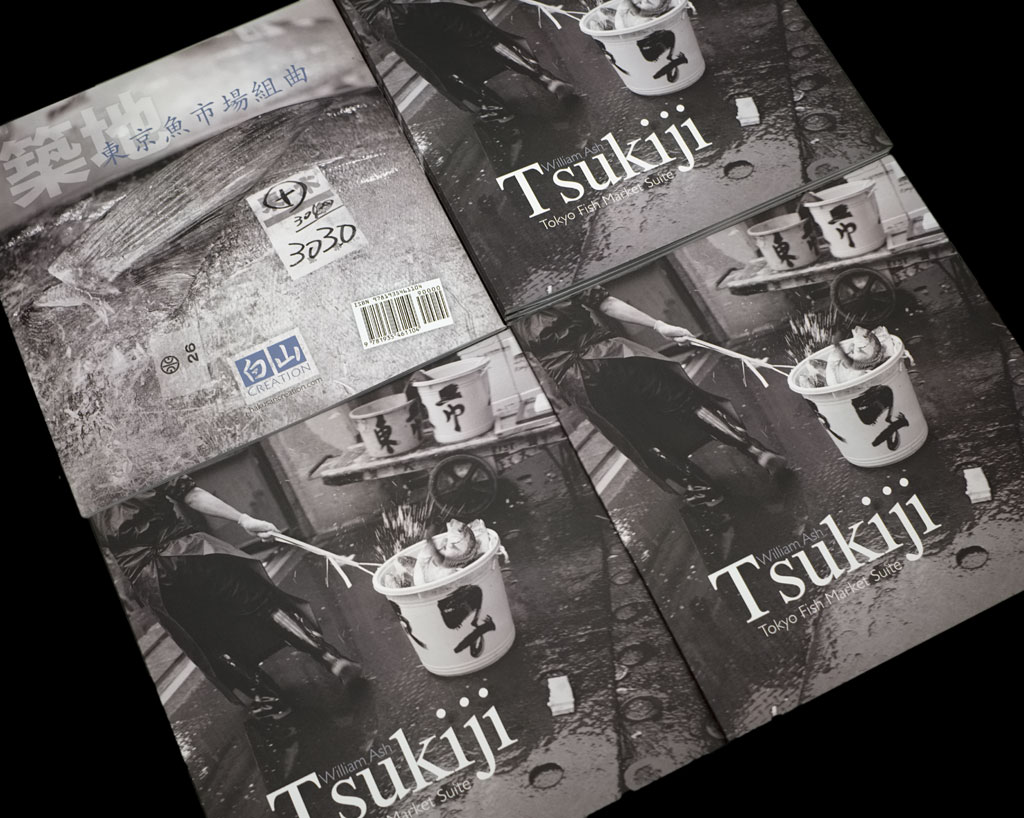 We have just received copies of our new book Tsukiji: Tokyo Fish Market Suite. It is a small 48 page book with 40 images documenting a day at the world’s largest fish market in Tokyo. The Tokyo metropolitan government has had long-term plans to close this market and this book is my homage to this place. The book will debut at the Griffin Museum of Photography during their Photobook Showcase this Sunday and we will have more about this title at Hakusan Creation soon.
We have just received copies of our new book Tsukiji: Tokyo Fish Market Suite. It is a small 48 page book with 40 images documenting a day at the world’s largest fish market in Tokyo. The Tokyo metropolitan government has had long-term plans to close this market and this book is my homage to this place. The book will debut at the Griffin Museum of Photography during their Photobook Showcase this Sunday and we will have more about this title at Hakusan Creation soon.
The Griffin Museum of Photography will be hosting events around publishing and the photo book on March 26th. From 10 am to 1 pm, Viginia Swanson will be hosting To Be Published, or Self Publish? From 2 pm to 4 pm, self-publishers, including us, will be showing their work during the Photobook Showcase. We hope to see you there.
Tsukiji: Coming Soon
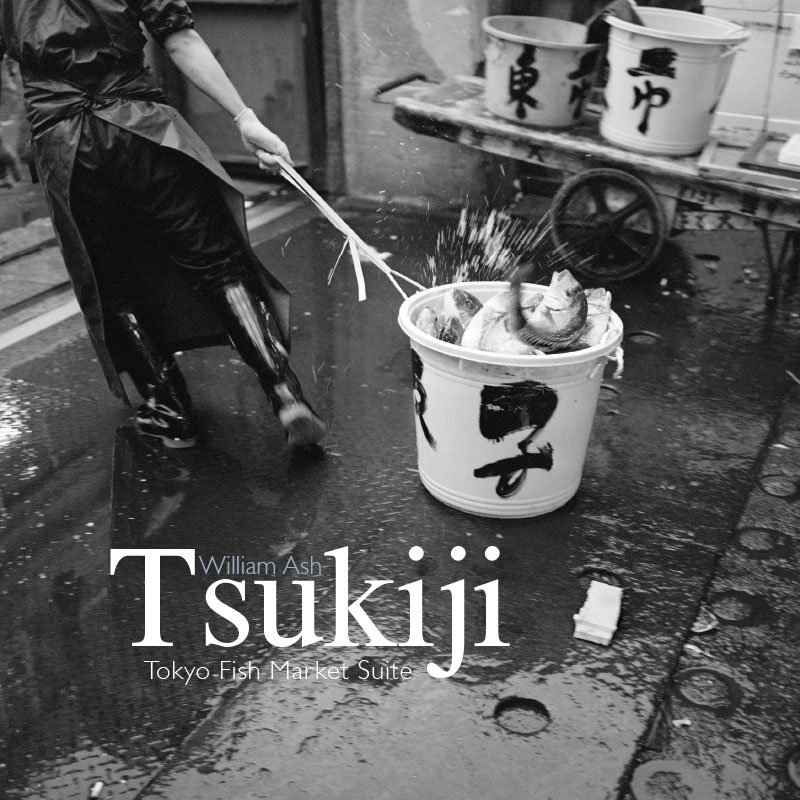 Naomi and I are pleased to announce our next book: Tsukiji: Tokyo Fish Market Suite. This 48 page soft cover book shows the inside of the world’s largest fish market. Tokyo Metropolitan Government has plans to relocate the market because of its aging 1935 infrastructure. This collection of 41 photographs pays homage to this remarkable place. The book will be released at the end of March. Click on the image for a larger view.
Naomi and I are pleased to announce our next book: Tsukiji: Tokyo Fish Market Suite. This 48 page soft cover book shows the inside of the world’s largest fish market. Tokyo Metropolitan Government has plans to relocate the market because of its aging 1935 infrastructure. This collection of 41 photographs pays homage to this remarkable place. The book will be released at the end of March. Click on the image for a larger view.
